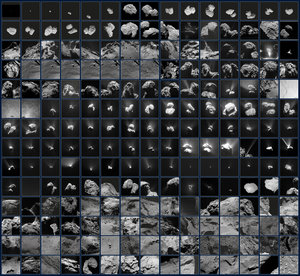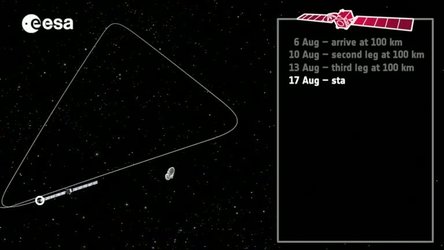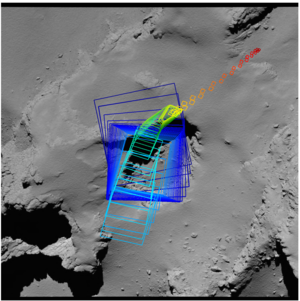Accept all cookies Accept only essential cookies See our Cookie Notice

About ESA
The European Space Agency (ESA) is Europe’s gateway to space. Its mission is to shape the development of Europe’s space capability and ensure that investment in space continues to deliver benefits to the citizens of Europe and the world.
Highlights
ESA - United space in Europe
This is ESA ESA facts Member States & Cooperating States Funding Director General Top management For Member State Delegations European vision European Space Policy ESA & EU Space Councils Responsibility & Sustainability Annual Report Calendar of meetings Corporate newsEstablishments & sites
ESA Headquarters ESA ESTEC ESA ESOC ESA ESRIN ESA EAC ESA ESAC Europe's Spaceport ESA ESEC ESA ECSAT Brussels Office Washington OfficeWorking with ESA
Business with ESA ESA Commercialisation Gateway Law at ESA Careers Cyber resilience at ESA IT at ESA Newsroom Partnerships Merchandising Licence Education Open Space Innovation Platform Integrity and Reporting Administrative Tribunal Health and SafetyMore about ESA
History ESA Historical Archives Exhibitions Publications Art & Culture ESA Merchandise Kids Diversity ESA Brand Centre ESA ChampionsLatest
Space in Member States
Find out more about space activities in our 23 Member States, and understand how ESA works together with their national agencies, institutions and organisations.
Science & Exploration
Exploring our Solar System and unlocking the secrets of the Universe
Go to topicAstronauts
Missions
Juice Euclid Webb Solar Orbiter BepiColombo Gaia ExoMars Cheops Exoplanet missions More missionsActivities
International Space Station Orion service module Gateway Concordia Caves & Pangaea BenefitsLatest
Space Safety
Protecting life and infrastructure on Earth and in orbit
Go to topicAsteroids
Asteroids and Planetary Defence Asteroid danger explained Flyeye telescope: asteroid detection Hera mission: asteroid deflection Near-Earth Object Coordination CentreSpace junk
About space debris Space debris by the numbers Space Environment Report In space refuelling, refurbishing and removingSafety from space
Clean Space ecodesign Zero Debris Technologies Space for Earth Supporting Sustainable DevelopmentLatest
Applications
Using space to benefit citizens and meet future challenges on Earth
Go to topicObserving the Earth
Observing the Earth Future EO Copernicus Meteorology Space for our climate Satellite missionsCommercialisation
ESA Commercialisation Gateway Open Space Innovation Platform Business Incubation ESA Space SolutionsLatest
Enabling & Support
Making space accessible and developing the technologies for the future
Go to topicBuilding missions
Space Engineering and Technology Test centre Laboratories Concurrent Design Facility Preparing for the future Shaping the Future Discovery and Preparation Advanced Concepts TeamSpace transportation
Space Transportation Ariane Vega Space Rider Future space transportation Boost! Europe's Spaceport Launches from Europe's Spaceport from 2012Latest

Landing site in sight
Thank you for liking
You have already liked this page, you can only like it once!
Friday 30 September 2016 was a bitter-sweet day for space exploration: the incredible Rosetta spacecraft reached the end of its hugely successful mission, fittingly, by touching down on the surface of the comet it had been studying from orbit for the previous two years.
This image was captured by the spacecraft’s wide-angle OSIRIS camera during the final hour of the mission from an altitude of about 400 m above the surface of Comet 67P/Churyumov-Gerasimenko. Its final resting place is not far from the top centre of the image; see also this breathtaking sequence of images covering the final hours of the mission.
Rosetta arrived at the comet on 6 August 2014 after a ten year journey through space, and deployed lander Philae to its surface on 12 November 2014. Rosetta continued to study the icy, dusty object from near and far as the comet reached its closest approach to the Sun in August 2015 and moved towards the outer Solar System again.
Conducting science until the very end, the descent gave Rosetta the opportunity to collect unique data on the comet’s gas, dust and plasma environment very close to its surface, as well as take very high-resolution images and temperature measurements.
While the mission operations have concluded, the science certainly continues. Intense activities also surround the preservation of Rosetta’s highest resolution and best calibrated data in ESA’s Planetary Science Archive, securing the mission’s legacy for future generations.
Last week marked another milestone as the final Science Working Team meeting was held at ESA’s technical facility in the Netherlands. It was the 52nd of such meetings, the first having been held in the late 1990s. The meeting closed out the formal aspect of the mission and archiving activities and enabled teams to reflect on their efforts over the last decades. In addition, several days were dedicated to the latest and ongoing science activities, which are delving deep into the cross-instrument analysis of the comet. A number of the topics discussed are also presented in a recently published special edition of Astronomy and Astrophysics.
-
CREDIT
ESA/Rosetta/MPS for OSIRIS Team MPS/UPD/LAM/IAA/SSO/INTA/UPM/DASP/IDA – CC BY-SA 4.0 -
LICENCE
ESA Standard Licence

Rosetta’s ever-changing view of a comet

Rosetta: the end is in sight

Rosetta’s final imaging sequence

Journey to the surface of a comet















 Germany
Germany
 Austria
Austria
 Belgium
Belgium
 Denmark
Denmark
 Spain
Spain
 Estonia
Estonia
 Finland
Finland
 France
France
 Greece
Greece
 Hungary
Hungary
 Ireland
Ireland
 Italy
Italy
 Luxembourg
Luxembourg
 Norway
Norway
 The Netherlands
The Netherlands
 Poland
Poland
 Portugal
Portugal
 Czechia
Czechia
 Romania
Romania
 United Kingdom
United Kingdom
 Slovenia
Slovenia
 Sweden
Sweden
 Switzerland
Switzerland
























